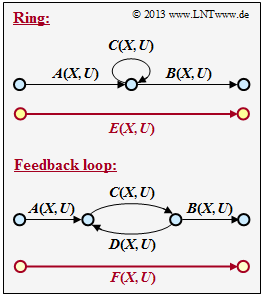Difference between revisions of "Aufgaben:Exercise 3.12Z: Ring and Feedback"
From LNTwww
| Line 2: | Line 2: | ||
[[File:EN_KC_Z_3_12.png|right|frame|Ring and feedback in the state transition diagram]] | [[File:EN_KC_Z_3_12.png|right|frame|Ring and feedback in the state transition diagram]] | ||
| − | In order to determine the path weighting enumerator function $T(X)$ of a convolutional code from the state transition diagram, it is necessary to reduce the diagram until it can be represented by a single connection from the initial state to the final state. | + | In order to determine the path weighting enumerator function $T(X)$ of a convolutional code from the state transition diagram, it is necessary to reduce the diagram until it can be represented by a single connection from the initial state to the final state. |
In the course of this diagram reduction can occur: | In the course of this diagram reduction can occur: | ||
* serial and parallel transitions, | * serial and parallel transitions, | ||
| + | |||
* a ring according to the sketch above, | * a ring according to the sketch above, | ||
| + | |||
* a feedback according to the sketch below. | * a feedback according to the sketch below. | ||
| − | For these two graphs, find the correspondences $E(X, \, U)$ and $F(X, \, U)$ depending on the given functions $A(X, \, U), \ B(X, \ U), \ C(X, \, U), \ D(X, \, U)$ . | + | For these two graphs, find the correspondences $E(X, \, U)$ and $F(X, \, U)$ depending on the given functions $A(X, \, U), \ B(X, \ U), \ C(X, \, U), \ D(X, \, U)$ . |
| Line 22: | Line 24: | ||
* This exercise belongs to the chapter [[Channel_Coding/Distance_Characteristics_and_Error_Probability_Bounds| "Distance Characteristics and Error Probability Bounds"]]. | * This exercise belongs to the chapter [[Channel_Coding/Distance_Characteristics_and_Error_Probability_Bounds| "Distance Characteristics and Error Probability Bounds"]]. | ||
| − | * This exercise is intended to prove some of the statements on the [[Channel_Coding/ | + | * This exercise is intended to prove some of the statements on the [[Channel_Coding/Distance_Characteristics_and_Error_Probability_Bounds#Rules_for_manipulating_the_state_transition_diagram|"Rules for manipulating the state transition diagram"]] section. |
| − | * Applied these rules in | + | |
| + | * Applied these rules in [[Aufgaben:Exercise_3.12:_Path_Weighting_Function|$\text{Exercise 3.12}$]] and [[Aufgaben:Exercise_3.13:_Path_Weighting_Function_again|$\text{Exercise 3.13}$]]. | ||
Revision as of 18:13, 22 November 2022
In order to determine the path weighting enumerator function $T(X)$ of a convolutional code from the state transition diagram, it is necessary to reduce the diagram until it can be represented by a single connection from the initial state to the final state.
In the course of this diagram reduction can occur:
- serial and parallel transitions,
- a ring according to the sketch above,
- a feedback according to the sketch below.
For these two graphs, find the correspondences $E(X, \, U)$ and $F(X, \, U)$ depending on the given functions $A(X, \, U), \ B(X, \ U), \ C(X, \, U), \ D(X, \, U)$ .
Hints:
- This exercise belongs to the chapter "Distance Characteristics and Error Probability Bounds".
- This exercise is intended to prove some of the statements on the "Rules for manipulating the state transition diagram" section.
- Applied these rules in $\text{Exercise 3.12}$ and $\text{Exercise 3.13}$.
Questions
Solution
(1) Correct are solutions 1 and 2:
- In general terms, one first goes from $S_1$ to $S_2$, remains $j$–times in the state $S_2 \ (j = 0, \ 1, \, 2, \ \text{ ...})$, and finally continues from $S_2$ to $S_3$.
(2) Correct is the solution suggestion 2:
- In accordance with the explanations for the subtask (1), one obtains for the substitution of the ring
- $$E \hspace{-0.15cm} \ = \ \hspace{-0.15cm} A \cdot B + A \cdot C \cdot B + A \cdot C^2 \cdot B + A \cdot C^3 \cdot B + \text{ ...} \hspace{0.1cm}=A \cdot B \cdot [1 + C + C^2+ C^3 +\text{ ...}\hspace{0.1cm}] \hspace{0.05cm}.$$
- The parenthesis expression gives $1/(1 \, –C)$.
- $$E(X, U) = \frac{A(X, U) \cdot B(X, U)}{1- C(X, U)} \hspace{0.05cm}.$$
(3) Correct are the solutions 1, 3 and 4:
- one goes first from $S_1$ to $S_2 \ \Rightarrow \ A(X, \, U)$,
- then from $S_2$ to $S_3 \ \Rightarrow \ C(X, \, U)$,
- then $j$–times back to $S_2$ and again to $S_3 \ (j = 0, \ 1, \ 2, \ \text{ ...} \ ) \ \Rightarrow \ E(X, \, U)$,
- finally from $S_3$ to $S_4 \ \Rightarrow \ B(X, \, U)$,
(4) Thus, the correct solution is suggested solution 1:
- According to the sample solution to subtask (3) applies:
- $$F(X, U) = A(X, U) \cdot C(X, U) \cdot E(X, U) \cdot B(X, U)\hspace{0.05cm}$$
- Here $E(X, \, U)$ describes the path "$j$–times" back to $S_2$ and again to $S_3 \ (j =0, \ 1, \ 2, \ \text{ ...})$:
- $$E(X, U) = 1 + D \cdot C + (1 + D)^2 + (1 + D)^3 + \text{ ...} \hspace{0.1cm}= \frac{1}{1-C \hspace{0.05cm} D} \hspace{0.3cm} \Rightarrow \hspace{0.3cm} F(X, U) = \frac{A(X, U) \cdot B(X, U)\cdot C(X, U)}{1- C(X, U) \cdot D(X, U)} \hspace{0.05cm}.$$
